
GABRIEL IBARRA
ARCHITECTURAL HISTORICAL PHOTOGRAPHY
Alviso · Barns · Coyote Valley · Orchards · Tank Houses and Wind Mills
Welcome to Gabriel's new Web site. This page was created to inform you about local History and landmarks that have a reference to Santa Clara Valley. I am presenting information not necessarily found in books.
There are numerous historical groups, museums and sites which can be accessed by interested parties.
You can write to Heritage Council of Santa Clara County at PO Box 26767, San Jose, Ca 95159 or visit their website:
| Alviso | ||
 |
The mural of the bayside Canning Co which is made up of six descriptive sections. From the Ohlones,Spanish Explorers,Gold Rush, R/Rd's,Orchard Era to everyday life. |
|
| 1776: Ignacio Alviso comes to the area from Mexico
1838: From a land grant from Mexican Governor Juan de Anza, the town of Alviso is built. It becomes a prosperous port from where items such as tallow, grains and quicksilver from the New Almaden mines are shipped all over the globe. 1849: Chester S. Lyman, a surveyor, laid out the town. 1852: The city of Alviso is incorporated. 1864: Alviso's boom ends with the completion of the San Francisco-San Jose Railroad. This ends it's role as a shipping center and port of entry from the Santa Clara Valley. |
||
A one of a kind website that is all about Alviso is reached at the link below:
Coyote Valley was once part of of "The Valley of Heart's Delight", combining fertile soil, an amiable climate and a flow of water to become an agricultural Eden_ but that role that would make farming a community resource.Farmers in the 6,800 acre valley, especially in the northern two thirds, have been dwindling away steadily in recent years as the city has changes zoning designations to alow for urban and industrial development. Now the dominant agricultural use for the land is to farm row crops and forage.The Green Belt Alliance wants to broaden the concept of agriculture from simply food production and commodity provision to a more service oriented definition.(That means not just depending on row crops that could easily be sold to large comodity trader); smaller 20-40 acre farms and community gardens; and intoducing the comunity to the farmers through educational programs in schools, farmers markets, harvesting festivals, farm to cafeteria programs, agrotourism and generally, having the Coyote Valley community sustain the farmers. Is that viable? Farms next to people have never been a good mix. "Once you tell what a farmer how he is going to farm, youre going to meet some resistance."
Sprawl, the Sequel
Brian Schmidt who works on legislative issues for Santa Clara County's Committee for Green foothills, is appreciative of the Greenbelt Alliance's vision but opposes the development of Coyote Valley period. "The point that we think is worth emphasizing is that {the vision} is not an endorsement for developing Coyote Valley," he says "But at the same time, the greenbelt proposal is far better than a typical proposal."Developing Coyote Valley - even if the development is catered toward an environmental sensitive philosophy inheritantly runs into problems, Shmidt says. For starters, parts of the valley have an especially high water table, which could lead to potential water-quality problems; the valley lies in a flood plain that threatens any potential devlopment; development threatens farming; and most importantly, developing Coyote Valley could very well be an inducement for further sprawl.He thinks that even the best projects cannot over come these issues.The prospect of seeing a good size city of 80,000 to 100,000 residents is disconcerting for Schmidt. He would like to see Greenbelt Alliance lessen the scope of the project instead of mirroring San Jose's goals for the valley(a possibility that Greenbelt Alliance mentioned during the unveiling of the proposal).Fitchen from Greenbelt Alliance only wants to put forward an alternative development solution, not push for development. "We laid out the issues," she says,"{and} what needs to happen. Now the city has to do an comprehensive study. If it turns out that development is not appropriate in a certain place on in the whole valley, we would be the first ones not to do it." Excerpt taken from article "Coyote Dreaming" by Najeeb Hasan Metro News, July 10-16 -03 My take on this article is that as usual the city of San Jose will ask for your comments and then do whatever they want to do. Their chief reason being, Oh well we spent so much money on the research we might as well just build the project. As far as something appropriate for the area, how appropriate has been the Calpine energy plant? Pure dumb buy outs by politicicians for their campaign funds. This is the last open space between San Jose and Morgan hill and we are supposed to trust the politicians to get it right. They want to put flowers, fountains, gardens and industrial parks where the third richest agricultural land in the world is; that is not smart thinking. I don't know about you but the produce you buy from Cosco is from Chile, Australia and Turkey and Bites Big Time-meaning it has no flavor. Furthermore they do not have the strict environmental laws for applying pesticides that we do. This is called a circle of poison. What ever happened to buy California and USA.The global economy is over rated and only serves the top two percent of the wealthiest people, it does not serve the common people. Write to mayor Ronner; he is on the committee to overall see that Coyote Valley is built up. I think that is a conflict of interest. Go figuire!
Places to see fruit orchards:
Where to find out more about the fruit industry:
If you are looking to tour or pick your own fruit and veggies from the source (over 100 commodities) then the Country Cross Roads Trails Map is for you. This map covers the Santa Clara and Santa Cruz County. Use a stamped self addressed enevelope.
Write to: Santa Clara Farm Bureau, 605 Tennant Ave. Suite B, Morgan Hill, CA 95037
 |
The Harris-Laas Windmill and Tank house on Market Street The site is significant as Santa Clara's last farm. c. 1864. This structure is part of the Harris-Laas Historic Preserve, which includes an eleven-room Italianate style house. A museum is on site with tours and open on Saturday and Sunday noon until 4:00 p.m. for a nominal admission. |
|
EMAIL: GUBBYPICS@NETSCAPE.NET
COPYRIGHT & COPY: 2004. GABRIEL IBARRA REVISED 04/16/04.